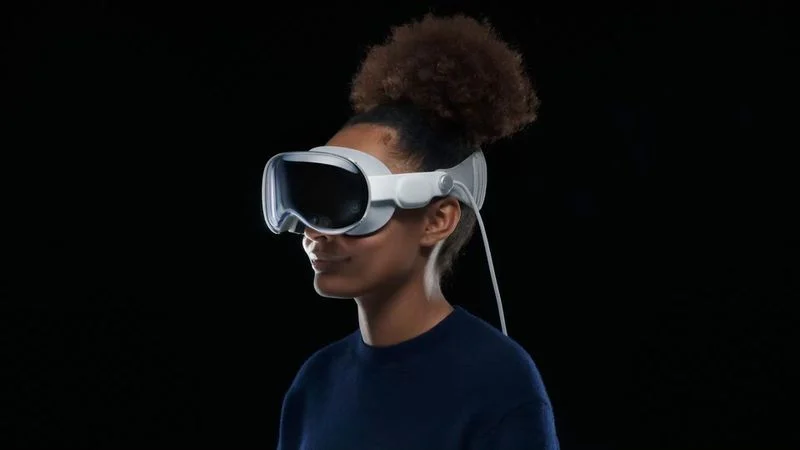
Apple Vision Pro
Apple Vision Pro is Apple’s augmented and virtual reality headset, a device that has been in development for more than a decade. Vision Pro marks the company’s first entrance into a major new product category since the 2015 Apple Watch, with the device introduced at WWDC 2023 in June. Apple began accepting pre-orders for the Vision Pro starting on January 19 at 5:00 a.m. Pacific Time, with a launch following on February 2.
While the Apple Vision Pro is definitely a headset, Apple does not use that word when referring to it. Instead, Apple calls it a spatial computer because of its ability to blend digital content with the physical world. Apple refers to the Vision Pro as the first spatial computing device.
Apple Vision Pro is a mixed reality headset that displays augmented reality content overlaid on the world around you, and immersive entirely virtual content, but it’s worth noting that the headset is not see through. Everything you see is digital. For augmented reality content that does not make your surroundings disappear, Apple uses cameras that map out what’s in front of you, translating that into a digital image augmented by virtual elements.
For a virtual reality experience, Apple shuts off those cameras and can make it seem like you are completely isolated from what’s going on around you, allowing you to focus solely on what’s being displayed on the headset’s screens. This shift between the “real” and the “immersive” can be controlled with an on-device Digital Crown.
Design wise, Apple Vision Pro is not unlike a pair of ski goggles, featuring a singular piece of laminated glass for the front that melds into an aluminum alloy frame. A soft, fitted Light Seal attaches magnetically to the frame and conforms to your face to block out light.
Two Audio Straps with built-in speakers are positioned at the sides of the headset, delivering Spatial Audio that blends what you’re hearing on the headset with what’s going on in the real world. The Audio Straps connect to a 3D knitted headband that holds the Vision Pro in place. Apple designed it to be breathable, cushiony, and stretchy for comfort, and a Fit Dial ensures the headset fits tight against your head. There’s also a dual-strap design that evenly distributes the weight between the back and top of the head. Apple plans to offer Light Seals and headbands in multiple sizes, and these components are swappable.
Inside the frame, there are two micro-OLED displays that deliver over 4K resolution to each eye for a total of 23 million pixels. There’s also an external display called EyeSight that projects an image of your eyes so people can tell whether you’re using the headset in an immersive mode or if you can see what’s going on around you. For glasses wearers, there are custom prescription Zeiss Optical Inserts that can be attached magnetically to the headset’s lenses.
There are no controllers for Apple Vision Pro, with the headset instead controlled by eye tracking, hand gestures, and voice commands. An app can be navigated to and highlighted by looking at it and then opened with a tap of the fingers. Scrolling is done with a simple flick of the fingers.
More than a dozen cameras and sensors in Apple Vision Pro map out the world around you, keeping track of your hand and eye movements. Optic ID, which scans your iris with infrared lights and cameras, is used for authentication. Each person has a unique iris pattern, and Optic ID is akin to Face ID and Touch ID. It can be used for unlocking the device, making purchases, and as a password replacement.
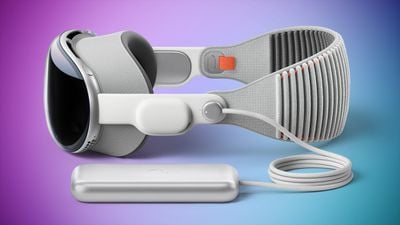
There are two Apple silicon chips inside Vision Pro, including the same M2 chip that’s in the Mac and a new R1 chip. The M2 chip runs visionOS, executes computer vision algorithms, and provides graphics, while the R1 chip processes input from the cameras, sensors, and microphones.
Apple Vision Pro can take 3D photos and videos using a built-in camera that’s powered by tapping on the top button of the device. Apple says that users can capture videos and photos in 3D and then relive those memories like never before. Vision Pro will also show existing photos and videos in large scale, making them more immersive. Note that when you are recording video, Vision Pro makes it clear that recording is happening with an animation on the external display.
Due to weight constraints, Apple did not put a battery in Apple Vision Pro. Instead, it can be powered by a braided cable that is attached to a battery pack worn at the hip or plugged into an adapter. The battery pack offers up to 2.5 hours of battery life on a single charge.
With Apple Vision Pro, content is displayed in the space around you. You can position apps and windows in mid-air, rearranging them as you see fit, with multiple windows supported. Apple says there’s an “infinite canvas” to work with. Apps can be displayed in the actual environment that you’re in so you can stay present with what’s going on around you, or you can use a more immersive view that shuts out the world and puts content on a virtual background called an Environment.
A visionOS operating system runs on Apple Vision Pro, and it has a dedicated App Store with apps designed specifically for the device, but it is also able to run iPhone and iPad apps. You can connect the Vision Pro to a Mac, with the headset serving as a display for the Mac. It works with Bluetooth accessories for text input and control, or you can use virtual typing or dictation for text.
There is a main Home View that has all of your favorite Apple apps like Mail, Messages, Music, Safari, Photos, and more, with your data synced through iCloud. The interface is similar to the iPhone interface, but you can open apps and arrange them virtually. Apple is updating its main apps for visionOS and has created APIs for developers, plus Apple is providing Vision Pro test kits to developers for app testing. Apple Vision Pro offers an immersive experience for entertainment like TV and movies, and the Apple TV app will offer more than 150 3D titles at launch. Content can be expanded to feel like it’s in your own personal theater, complete with spatial audio.
FaceTime has been redesigned for Vision Pro. People on the call are shown in large tiles to the headset wearer, while the headset wearer is shown as an accurate digital recreation using their Digital Persona. With FaceTime, Vision Pro users can collaborate on documents with colleagues or share apps with others, and spatial audio makes it clear who is speaking.
The Cinema Environment allows you to watch shows and movies at the frame rate and aspect ratio chosen by the creator, or you can use a nature-themed Environment to make the screen feel 100 feet wide. Apple created Apple Immersive Videos that are 180-degree 3D 8K recordings that put users right inside the action, plus streaming services like Apple TV+ and Disney+ are available on Vision Pro. As for gaming, Vision Pro supports Apple Arcade, with 100 iPad games to be available at launch. Games can be played with Bluetooth game controllers that connect to the headset.
Apple Vision Pro is priced starting at $3,499 and it launched on February 2, 2024. It is currently only available in the United States, with Apple accepting orders both online and in retail stores.
How to Buy
The Apple Vision Pro launched on Friday, February 2, 2024, following the start of pre-orders January 19. Demos sessions at Apple retail stores became available starting on February 2 for those who want to try out the headset before making a purchase. Pre-orders largely sold out, and the Vision Pro is listing shipping times into March, although Apple retail stores appear to have limited walk-in stock available.. Apple analyst Ming-Chi Kuo believes Apple has sold up to 180,000 Vision Pro headsets so far.
The Vision Pro is available in U.S. retail stores and for purchase from the U.S. online store. Apple is providing demonstrations in all of its Apple retail locations.
Pricing starts at $3,500 for 256GB of storage space. The ordering process requires a Face ID scan to help customers determine the correct Light Seal and head band fit.
Zeiss reading lenses for the Vision Pro cost an additional $99, while custom prescription lens inserts are priced at $149. A valid unexpired prescription from a U.S. eye care professional will need to be uploaded after purchase in order to get custom prescription lens inserts.
What’s in the Box
The Vision Pro ships with two bands, the Solo Knit Band and the Dual Loop Band. It also comes with a Light Seal, two Light Seal Cushions in different sizes, an Apple Vision Pro Cover for when the headset is not in use, a Polishing Cloth, a battery, a USB-C charging cable, and a USB-C power adapter.
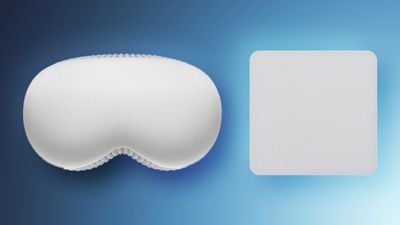
Additional Countries
Rumors suggest that the Vision Pro will launch in China “no later than May,” with other countries to follow before the end of the year.
Vision Pro Reviews
Vision Pro reviews are mixed overall. For the most part, reviewers have been impressed with the hardware and the technology introduced by the Vision Pro, but there are questions about the actual function of the device, the intuitiveness of the gesture-based control, the weight and comfort, and VR in general.
The Verge‘s Nilay Patel offers one of the best Vision Pro overviews. He said it is clear that Apple has the absolute best hardware introduced in a VR headset to date, but there are still major tradeoffs to deal with. Patel found the Vision Pro uncomfortable to wear for long periods of time, and was not a fan of the fit because of its impact on hair and makeup.
He found the Vision Pro to be isolating, and said that the “in there” experience of VR did not come close to the “out there” experience of working in the real world with external devices like the Mac. “You’re in there, having experiences all by yourself that no one else can take part in,” Patel wrote. “I’ve come to agree with what Tim Cook has been saying for so long: headsets are inherently isolating.”
The Wall Street Journal‘s Joanna Stern said that the hand gestures captured by cameras in the headset were intuitive, and that navigation made sense. But sometimes the eye tracking didn’t respond to movement, and Patel said he found it distracting to have to be looking at what he wanted to manipulate because that’s not the experience on a Mac or an iPhone.
The virtual in-the-air keyboard “will drive you mad for anything longer than a short message,” according to Stern. To do any “real work,” users will need a Bluetooth keyboard and mouse.
The EyeSight external display was universally disliked by reviewers who found it blurry, unrealistic, and hard to see at best, and creepy at worst. The same goes for Personas. Reviewers did not find them to be an accurate representation of themselves, and others viewing the Personas found them strange and in uncanny valley territory.
Apple’s internal microOLED displays were better received, and reviewers praised the quality, sharpness, and low latency of the display for watching movies, working, and similar tasks. Some pointed out that the color range is more limited than expected, and that there is vignetting at the sides of the display due to the shape of the device.
There’s also motion blur, and the cameras work less well in low-light conditions, leading to blurry text and images that are hard to see. That’s a problem when the Vision Pro is used in an augmented reality mode, as the cameras are showing a passthrough feed of what’s around the wearer. Patel said that it is by far the best video passthrough device to date, but it’s still just not as good as looking at the real world.
There were no overly impressive app experiences or VR games, though reviewers were impressed with the ability to place windows of any size anywhere in the space around them. Window management is not intuitive, though, and while the Vision Pro can serve as a display for the Mac, users can only set up a single Mac display in visionOS, rather than having a setup that looks like multiple Mac monitors.
CNET‘s Scott Stein was surprised at the lack of blending of virtual and reality in apps or environments given Apple’s focus on AR. “I haven’t seen virtual things hop on my sofa, or run behind furniture. I haven’t placed apps on walls or turned windows into aquariums,” he said. Apple’s ARKit on iOS already can do this, but so far Vision Pro isn’t emphasizing these tricks.
Reviewers agreed that watching TV and movies was one of the best use cases for the Vision Pro, and Patel said that there is a case to be made for using it as a very expensive TV. There were more mixed reactions to Apple’s 3D content, though.
Stern said that every time she watched one of the 3D 180-degree videos that Apple created for the Vision Pro, she felt nauseous, and Patel also said that spatial videos and other content with a lot of motion can cause nausea. Stein felt that while the videos look impressive, the frame rate and resolution “don’t feel good enough to be ultra-real yet.”
The speakers work well and offer decent audio, but they are not isolated and others around the user can hear what’s on the headset. Though there are cameras that can capture photos and videos, the quality is not good enough. Stein said he would “never wear the Vision Pro to take photos and videos of [his] family.”
No one minded the battery too much, because the Vision Pro is a headset that is largely meant to be used while seated. Battery life was a bit longer than two hours in most tests, which is in line with what Apple has said.
Both Stern and Patel described the Vision Pro as a clear first-generation product that shows some of the promise of the functionality that might be available as AR and VR technology progress and Apple is able to build a better device.
As the Vision Pro is a niche product, reviewers did not recommend the Vision Pro to the average consumer, and said that most people will not want to spend the $3,500 on it. “The Vision Pro isn’t a device I’d recommend to any of my friends or family,” said Stein.
How It Works
Apple Vision Pro is a “mixed reality” headset, meaning it can display both virtual and augmented reality content. It is not like augmented reality glasses, however, as it is designed to completely cover the eyes and block out all of your surroundings.
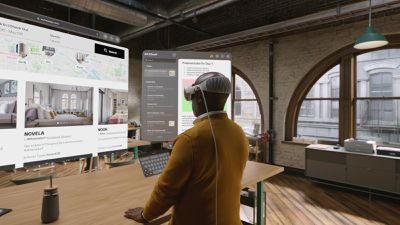
Apple is using exterior and interior cameras for the augmented reality component of the device. The cameras are able to map the space around you and project the real world back to you, so though you’re not actually looking at what’s around you using see-through glasses, you are effectively seeing an accurate picture of your real world environment.
With this capability, Apple can show you 3D windows, objects, and content in your actual space, or the cameras can be turned off to shut out the world to provide an entirely virtual setting. Apple is focusing on the headset’s ability to allow for working, content consumption, gaming, communication and other activities to be done “anywhere” with just the Vision Pro.
Design
Vision Pro is Apple’s wearable “spatial computing” device, and while Apple does not refer to it as a headset, that’s exactly what it is. The Apple Vision Pro is worn over the head, and it is a virtual/augmented reality headset similar to the PlayStation VR or Meta Quest.
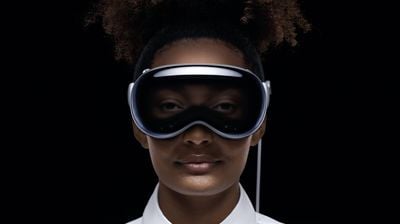
Design wise, the Vision Pro looks similar to a pair of ski goggles, albeit high-end goggles. It features a laminated glass front, which Apple says was “three-dimensionally formed.” The glass is attached to a curved aluminum alloy frame that wraps around the face. As of now, the headset is only available in silver with matching gray Light Seals and bands.
The frame connects magnetically to a Light Seal that sits on the face, and Apple offers the Light Seal in a range of sizes and shapes to fit different faces. A tight fit with the Light Seal is essential for blocking out light and proper operation of the headset. Apple designed the Light Seal to be flexible so that it can conform to individual face shapes. An ill-fitting Light Seal causes the Vision Pro display to be blurry and it allows light to creep in.
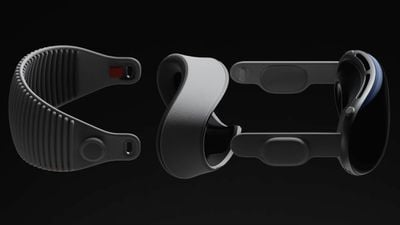
At the side of the headset, there are two audio straps that are equipped with speakers that support spatial audio. The audio straps connect to a 3D braided fabric Solo Knit Band that secures the headset to the back of the head, with an adjustable dial for tightening it up for a customizable fit. The main braided headband is detachable so users will be able to swap in different sizes, and perhaps different designs if Apple makes those available in the future.
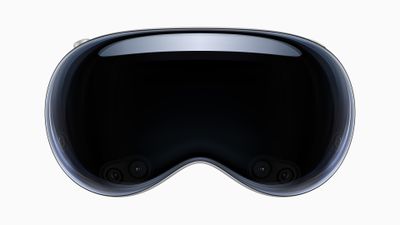
The Vision Pro comes with both the aforementioned Solo Knit Band that fits around the back of the head and a Dual Loop Band that goes around the back of the head and over the top of the head for weight distribution, so users can choose the best fit. The Dual Loop Band has a two-strap design and it is not made of the same braided material as the Solo Knit Band.
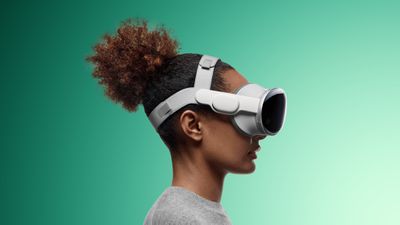
Early testers of the Vision Pro have found that the Dual Loop Band is more comfortable as the headset has been described as heavy. Multiple reviews have mentioned the weight of the device and have said that it can be uncomfortable to wear. The Vision Pro weighs between 21.2 and 22.9 ounces (600 and 650 grams) depending on which Light Seal and head band are used on the device.
Physical controls include a Digital Crown at the top that changes your level of “immersion” and to show you more or less of your real world surroundings through “Environments,” and a top button that serves as a camera button for capturing 3D “spatial” videos and photos.
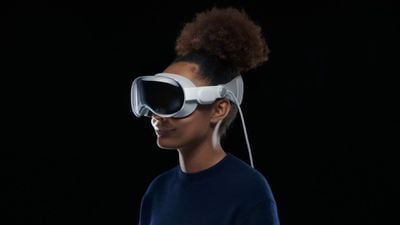
On the left side of the headset, there is a space to attach a braided cable that provides power to the device. The round charging puck looks like an Apple Watch charging puck, but it clicks into the headset securely with a rotation gesture.
The charging cable attaches to either an external battery pack worn at the waist or a power adapter connected to the wall.
Display
Apple Vision Pro is equipped with two custom micro-OLED displays that provide a total of 23 million pixels, which Apple says is “more pixels than a 4K TV.” The headset displays feature a 90Hz refresh rate, but there is a 96Hz refresh rate that can be activated when watching 24 fps movies.
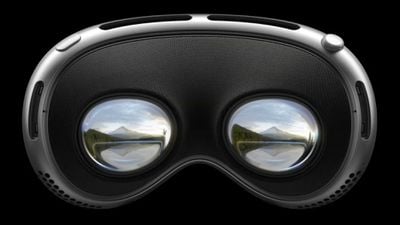
The displays have been described as the size of a postage stamp, but specific hardware information is not known yet.
There’s also an external “EyeSight” display that shows the headset wearer’s eyes to the people in the room around them. The feature is designed to allow people to know if the headset wearer is using a less immersive augmented reality mode or a fully immersive virtual reality mode.
The eye display that is shown on the exterior display comes from an interior camera that is monitoring the wearer’s eyes. It can also alert people when you are recording video with the external camera.
Lens Inserts
Apple Vision Pro customers who wear glasses will be able to order Zeiss Optical inserts with their prescription. Zeiss lenses are priced at $149 for a custom prescription, or $99 for readers. The lenses attach magnetically to the displays inside the headset, and can be engraved on the edge.
Zeiss lenses are available for prescriptions within -11.00D to +6.75D, and prescriptions with prisms are not supported at this time. Vision Pro can be used with soft contacts, but it is not compatible with hard contact lenses.
Cameras and Sensors
Apple Vision Pro includes 12 cameras and five sensors for monitoring hand gestures and mapping the external environment.

Two of the cameras transmit more than a billion pixels per second to the display to depict the real world around the wearer when using augmented reality mode, while the others are used for head tracking, hand tracking, and real-time 3D mapping.
Infrared flood illuminators enhance hand tracking in low-light conditions, and LiDAR depth sensors determine the size and location of objects in the room around you.
![]()
Four infrared cameras and LED lights are inside the headset for eye tracking purposes. With this technology, the Vision Pro is able to tell exactly where the wearer is looking for navigation purposes.
Navigation
There are no physical controls for the Vision Pro. Navigation is done through eye movements, hand gestures, and voice-based commands. In visionOS, for example, you can highlight an element like an app icon by looking at it, using a quick hand gesture to launch the app.
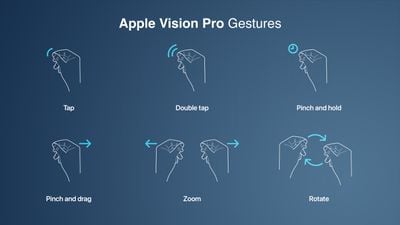
Bluetooth keyboards, mice, trackpads, and game controllers can be connected to Vision Pro as an alternative navigation method, though these are mainly designed to be used with a connection to the Mac and for Apple Arcade games.
Eye and gesture-based navigation is demonstrated in onboarding videos that were pulled from the visionOS software. Apple walks users through looking at a system element and selecting it with a tap of the fingers. The headset is able to detect hand movements even when the hands are resting comfortably in the lap.
Optic ID
The infrared cameras and LED lights inside the Vision Pro are used for a security feature called Optic ID. Optic ID is similar to Touch ID or Face ID, but it uses iris scanning instead of a facial scan or a fingerprint scan.
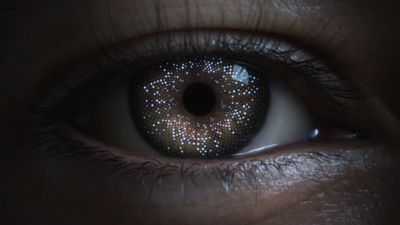
Each person has a unique iris pattern, which the headset is able to detect to keep sensitive data on the headset secure. Optic ID can be used like Face ID for unlocking the device, authenticating purchases, and as a password alternative.
3D Camera
Apple included an exterior camera that is able to capture 3D video and 3D photos that are viewable in 3D on the Vision Pro. Apple says that these are like reliving a memory in person because of the “incredible depth” that’s available.
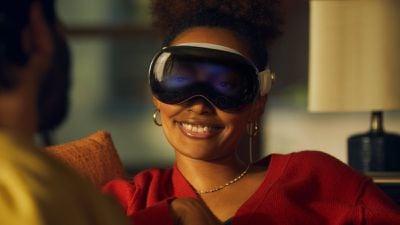
The camera gives a clear indicator when recording is turned on so that the headset cannot be used to secretly record video.
Several members of the media have been able to test the spatial video feature on the Vision Pro, and the feature has been described as so lifelike that it’s almost creepy. The Wall Street Journal‘s Joanna Stern said that it creates intimacy that 2D photos do not, while CNET‘s Scott Stein said that the videos are easy to record with the iPhone 15 Pro models and look “compellingly realistic.”
Audio
There are speakers on either side of the headset, with the speakers built into the straps that are connected to the frame. The speakers feature dual-driver audio pods that are positioned next to each ear, and they are able to analyze a room’s acoustic properties to adapt the sound to match the space.
The speakers support spatial audio for an immersive surround sound experience, plus there are also six microphones for phone calls, video calls, and voice commands.
The Apple Vision Pro will pair with the AirPods for a superior audio experience, and the USB-C AirPods Pro released in September 2023 support 20-bit, 48 kHz lossless audio with ultra-low latency when connected to the Vision Pro.
Connectivity
The Vision Pro supports Wi-Fi 6, which operates on the 2.4GHz and 5GHz bands. It does not include support for the faster Wi-Fi 6E specification that is compatible with the 6GHz band.
Processors and RAM
Apple Vision Pro is powered by a pair of chips. The main processor is the M2, which is the same chip that was first introduced in the 2022 MacBook Air. It is responsible for processing content, running the visionOS operating system, executing computer vision algorithms, and providing graphical content. The M2 chip that is in the Vision Pro features an 8-core CPU and 10-core GPU.
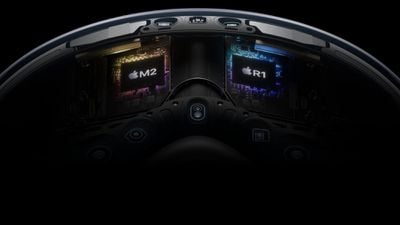
A second R1 chip is responsible for all of the information coming from the cameras, sensors, and microphones. Apple says that it can stream images to the displays within 12 milliseconds, providing a “virtually lag-free” view of the world.
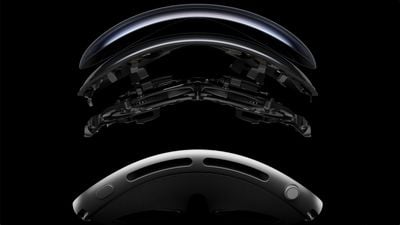
There is a thermal system inside the Vision Pro that is designed to quietly move air through the headset to control heat and optimize performance.
The Vision Pro headset will use dynamic random access memory or DRAM that is custom designed to support the R1 input processing chip. SK hynix will supply Apple with 1-gigabit low latency DRAM chips that have an increased number of input and output pins to minimize delays. The headset will have 16GB of RAM.
Storage Space
The entry-level Vision Pro is equipped with 256GB of storage space, but Apple also offers upgraded options with 512GB and 1TB of storage.
Battery Life
With the external battery pack, the Vision Pro can run for up to two and a half hours, with the 2.5 hour rating listed for watching 2D video. Apple says that the Vision Pro lasts for two hours for general usage. Battery packs can be swapped out for additional power on the go, but the device ships with a single battery pack. When plugged in to a power adapter, the Vision Pro can run all day.
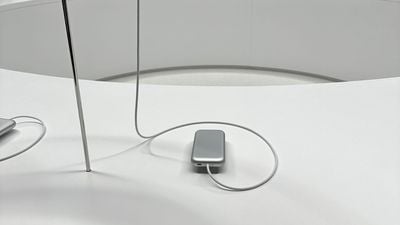
visionOS
Apple Vision Pro runs visionOS, an operating system that Apple designed specifically for the headset. visionOS is designed to provide an “infinite canvas” with app windows able to go anywhere in the space surrounding the user.

Apple redesigned apps like Safari, FaceTime, Messages, and more to work in a 3D environment, plus the headset is able to run the full catalog of iPhone and iPad apps. iPhone and iPad apps aren’t optimized for 3D, but can be used on the virtual canvas.
Movies and TV shows are available through Apple TV+ and other apps, and can be adjusted to look they’re on a screen that’s “100 feet wide.” visionOS has its own App Store, and specially created immersive 3D content created by Apple.
visionOS is described by Apple as the first spatial operating system because it can be controlled with eyes and hand gestures, with no physical controls necessary.
Mac Integration
visionOS can be used with a Mac, serving as a display. It works as a giant external display for Mac content, with familiar controls available through connected keyboards, mice, and trackpads.
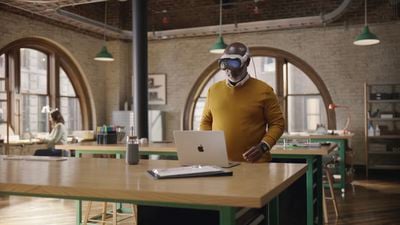
When connected to a Mac, the Vision Pro provides a single Mac display, so it is not possible for a setup that looks like you have multiple displays with Mac apps alone. The Mac interface can, however, be used alongside Vision Pro apps for a multi-window experience.
Current Version
The current version of visionOS is 1.0.2, with the software released just ahead of when the Vision Pro launched. Apple is also testing a visionOS 1.1 update, which improves Personas, adds mobile device management support, adds iMessage Contact Key Verification support, and more.
